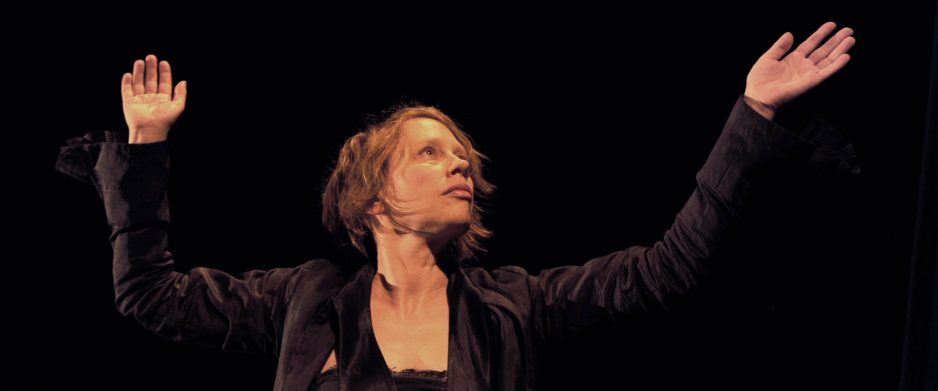Home | Blog | Still Point Turning
Still Point Turning
Image: Heidrun Löhr
Wooden sandals float on lit legs, set against a mechanical tick, symbolising a surreal introduction to the chronological.
We are captive to the multi-disciplinary installation dedicated to time, where all components sit equally in the space, to create an environment, which feels like a waking dream. This is Linda Luke’s latest offering titled Still Point Turning.
She dances in accompaniment to the soundscape composed by Vic McEwan, a video component and a weighted object, suspended down stage, held taut and released, to swing until the lights fade on Linda’s gaze, connecting with every member of the audience in intimate rapport. At one point Linda moves with several shadow selves, appearing simultaneously on a black background and amongst swirling cosmic dust.
The first work I had seen of Linda’s was Some Other Body, a solo created on Angela French for an initiative called Dance Meets Music, in partnership with the Sydney Conservatory of Music and youMove. Like this work, Linda created a unique environment, with clever shadow play. The intent continually shifting to reveal a new facet of the body as it traverses the stage under subtle lighting developments.
Martin Fox’s video appears in thin lines that cut vertically and horizontally, marking the space with regularity, at one point, like a scanner or the gentle automated voice which tells you how many seconds, after which minute, of what hour. I appreciated the effort it took to try and discern the images that flashed before me, that I wasn’t merely a passive observer.
Linda’s core practice is Body Weather, a movement ideology which “conceives of the body as a force of nature: omni-centered, anti-hierarchic, and acutely sensitive to external stimuli.” (Wikipedia) Linda has traveled to Japan to study with its founder Min Tanaka, where the training students receive is centred around the labour of workday tasks, primarily in agriculture. Tanaka teaches that performing such tasks in their environments and with their accompanying physical stimulations, functioned as a dance student’s teacher itself, overturning the tradition of the environment, taking on a subordinate role to the dance student’s technique. Linda has also trained with Tess de Quincey, an experienced Body Weather practitioner in Sydney, for several years.
This work is representative of the epic, the mechanical and emotional, measurements demarcating the subjective and the mathematic simultaneously. The overall pace was slow and considered, generously allowing my mind to fill the space with rapidity and to contemplate my relationship to the subject matter continually.
– by Vicki Van Hout

